
Полная версия
Remember this! Don’t let it sink into oblivion! Second edition. The life and death of the Pioneer Base «Oceanrybflot»
staff, he left the Navy, received his second higher education and since 1990 began to work in the base. In November 1998, he was elected CEO of Zapmorphlot LLC. The company has two TSM-class fishing vessels. The company’s products are well known to customers from Canada, Japan, China and Denmark.
In July 1947, the Neukuhren Fish Factory became the Pioneersk Fish Factory. In August 1947, on the orders of the Baltic State Fisheries Trust for No. 114, the trawling fleet management (UTF) was organized as an independent economic settlement enterprise in the Pioneersk region of Kaliningrad. G.Y. Ermoshkin was approved as the chief.
In the severe weather conditions of the Baltic, in January- February 1948, the captain of the MRT-50 Peter Yermolayev took on a voyage to the Baltic only those who expressed a desire. Fortune was favourable daredevils. The catch was about five tons. With great difficulty managed to pick up the catch and trawl on board, not having any devices on the ship. So many fish rarely mined. In early June, the crew of MRT-33 “Terrible” Captain Zimovin P.A. extracted 240 tons. This made up the annual plan.
The ships continued to arrive. The total capacity of the fleet was 9,000 horsepower. Fish production increased to 3060 tons. We caught mainly cod, flounder, sprat. In the same year, a 150-metre-long wooden pier and a new fishery building, which was located on the beach, were built. Production at the plant was 457,5 tons, and all products were sold at 1641.6 thousand rubles.
In 1948, construction began on the fish port, which was the second largest in the region. To improve the range of manufactured products built a shop by smoking. In June 1948, Konstantin Sobolev, an experienced fishing captain from Murmansk, who served in this position until 1952, was appointed head of the UTF. The chief engineer was Vasily Albanov.
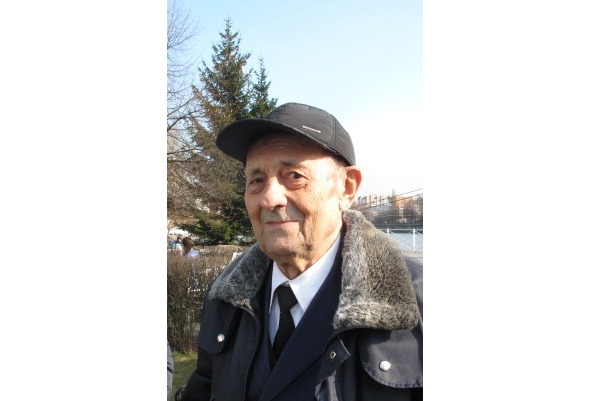
Dmitry Vasilyevich Ershov.
In the winter of 1949, for the first time captains P.A. Zimovin, P.L. Yermolayev, A.I. Ivanov went to the central part of the Baltic. In the area of the island of Gotland, they started fishing cod. Captains Pavel Bilyak and Grigory Glukhov are included in the regional Book of Honor of the winners of the socialist competition. Also noted are the mechanics Pavel Markianov, Ivan Britikov, Mikhail Venin.
In the same year, a 19-year-old boy was hired as a sailor on MRT-262 “Octopus” Dmitry Vasilyevich Ershov, born in 1930. That’s foto his at the end of March 2016. It is still strong and serves as an example of resilience and love for life. Since 1970 he worked as a mechanic and senior mechanic on the ships of the base. He has been awarded many medals for his work. I want to bring his memories of those times. He wrote an article on my blog, “The give birth of our fish industry.” I bring it completely, observing the style of the author.
“As pioneersk fishermens helped to fill the warehouses of the native land. I have a special date this year. 65 years ago, in 1949, I joined the fishing fleet. Namely – to the Office of the Trawl Fleet, which was in Pioneersk. A 19-year-old boy, I got a job as a sailor on an MRT-262 Octopus. And for many years after that I lived with the ship’s residence permit. Lived like a snail – my house was where the ship was. The formation of the region and the Kaliningrad fishing fleet took place before my eyes. During this time I have studied the history of the region’s fish industry well, taking a direct part in its work.
Along the way he studied – in Mamonovsky UCC (training and course combine), in ShukKPS (school of improvement of personnel of the command boat), in the maritime school.
But a special place in my destiny is occupied by the city of Pioneersk – former Neukuhren.
.. On April 14, 1945, units of the Red Army took possession of Neukuhren. The local port was then two powerful mauls – northern and eastern. There was also a small wooden pier in the southeastern part of the water area. In the northwest part was stranded with numerous boulders. Construction of the port began in 1902. But it was never completed. The war-torn country was in dire need of food. And the fish was supposed to be a powerful help here. On June 14, 1945, an order was issued by Narkomrybprom on the formation of the Baltgosrybtrest. And in July, forty-sixth, our fish factory was being created at an old German fish processing plant a couple of kilometres west of Wanger Bay in Neukuhren. And soon the first catch was brought to Koenigsberg, just renamed Kaliningrad.
Delivery of fish to Tchaikovsky Street, 49—51, where the trust was managed, was entrusted to Ivan Baskakov, a member of the war, a lieutenant. Subsequently, Ivan Ageevich became a senior mechanic of SRT-4294 (in 1957 I was his third mechanic). On July 26, 1947 Neukuhren was renamed Pioneersk. And on September 1 of the same year, UTF was created (Office of the Trawl Fleet), which is located in the house No. 1 on the street of the Embankment. Thus, Neukuhren-Pioneersk became a kind of maternity home of the fishing industry of the Kaliningrad region.
Most of the specialists among the first fishermen came from the ranks of the army and navy. Thus, in 1949, the chief engineer of UTF was the captain of the 2nd rank of Patrakeev, and the group mechanic – Senior 2 articles Daniluk (graduating in 1941 Odessa Maritime School). Deputy head of Belokurov, head of human resources Anufrievsky, captains Chechetkin, Novostavsky, Glukhov, Zabenin, Polonsky, Zimovin, Pukinsky, Medvedev – all transferred from the military. Our fishing fleet consisted then mainly of wooden vessels of the type KFC and boats, most of which did not even have radio stations.
This problem was solved by stations removed from aircraft. In Pioneersk then, in particular, the base of torpedo carriers of the Baltic Fleet was stationed. Sometimes, along with radio stations, radio telegraph players came to us. All in the same so memorable for me 1949, in October, began to come vessels such as MRT of the Finnish building (in the account of reparations). At that time – excellent sea vessels onboard trawling for coastal fishing. In 1950 Konstantin Andreevich Sobolev was appointed head of the UTF. At the same time began the construction of piers and cleaning of the water area of the port from the boulders, which here and there were sticking out of the water.
I can’t help but mention the incident that occurred in the spring of 1951.
In that spring appeal, the district military enlistment office of the city suddenly sent summonses to half of the workers of the fleet. They were young fishermen, like me, who had a residence permit on the ship. If they had all been called then, the fishing would have been disrupted. Because of the incompleteship of ship crews. Sobolev, having learned about it, flew to Moscow on an emergency military plane directly from Pioneersk. And there he appeared in the Central Committee of the party with a request for help. Returning the next day early in the morning, Sobolev came to the military enlistment office and, making his way among the slumbering conscripts from Pioneersk (slept on the floor, waiting to be sent to the troops), went to the office of the military enlistment office. And twenty minutes later he came out of there and said:
– “Which of the trawling fleet must lift up! The bus is waiting on the street. Go back to your ships immediately. And in the sea – to catch fish.
Sobolev is from Archagelsk, a hereditary fisherman. He was demanding and harsh.
For example, once he had to “educate” two of our captains. N. and G. went for a walk. As a result, two ships could not go out to sea. Sobolev summoned them to his cabinet, closed the door. And when he came to G., who was closer, he suddenly hit him so hard that he flew across the table. N., seeing this, jumped out the open window. Needless to say, soon both of the captains walked out into the sea.
In 1951, the Fishermen’s Culture House opened in Pioneers. In 1952, four SRTs left our port into the Atlantic. In 1959, a tuna expedition to the Central-East Atlantic was organized by two vessels of pioneering UTF – SRTR “Oskol” and “Orehovo” under the leadership of Dolgov and Kadilnikov. It was possible to open a tuna fishing area. It was a great success.
And in 1963, UTF was renamed the Pioneers Base of the Ocean Fishing Fleet. PBORF already had an impressive fishing fleet, which included vessels of various types: SRT, SRTR, SRTM, SRTMK. The port had mooring lines of 725 meters with powerful equipment for unloading and loading work and a good repair base. STR, STM, and even tropic-type vessels began to arrive. PBORF played a prominent role in the region’s economy. And Pioneers budget was 70 percent formed by the contributions of the fishing industry. But, alas, in the 90s came a black streak for the region’s fisheries industry as a whole, and for PBORF. As a result, today we have almost no fishing fleet, and our specialists work on foreign vessels. Shame. And there’s nothing you can see about the end of this black stripe.
Now the Pioneersk port near the entrance part is shallow, currents and storms bring it sand. The depth at the entrance is already only two and a half meters. Cleaning is needed, and finances are not allowed to do so. There were a lot of plans in this regard, but all of them were so on paper and remained…
I lived in Pioneer for a long time. On the street of the Embankment, house number 4, which is on the very shore. I worked at the Pioneersk UTF, then in PBORF. My children were born in this city. The eldest son, having graduated from KVIMU, thirty years went to the seas, having gone from sailor to captain on heavy-duty ships. Unfortunately, he often went to foreign courts. Now he works in the port administration. My grandson followed in my footsteps, too. He graduated from the BGA, now works as a senior assistant captain on gas vessels. However, also foreign…
I, a former mechanic and founder of our ershov sea dynasty, am proud of what happened. But nostalgia is tormented. Oh, that nostalgia!..
From the glorious past we, the old fishermen, were left with only memories yes Holiday – Fisherman’s Day..
.And yet I want to believe that the Kaliningrad fish industry will be revived. And Pioneersk town will regain the former glory of the fishing city.”
The MRT (small fishing trawler) of finnish construction had the following data: length – 23.6 meters, width – 6.5 meters, precipitation in cargo – 2.74 meters. Water displacement – 162 tons. The payload capacity is 30 tons. Swimming autonomy – 10 days. Engine power – 200 hp. Trawl winch – traction force – 2.0 tons. Speed: 9 knots. There are 11 beds.
In mid-May 1950, the crew of the trawler “Zutis” (Captain Aleksey Kucherenko) for the first time in the UTF went on a long voyage to the Baltic (fifteen days). Fifty tons were caught. At a rally on the occasion of the arrival at the port, Alexey Kucherenko said: “This voyage we proved that on our small fishing trawler not only it is possible to go out hundreds of miles from the shore, but also to carry out continuous fishing for 15—20 days.”
The same idea was expressed a little later, sending the first herring expedition to the Atlantic, the Minister of Fisheries Industry of the USSR A. A. Ishkov. He said: “Your first voyage is reconnaissance, experimental. It will be difficult in every way. There will be difficulties in the development of the area new for the Soviet fishing industry and in the operation of new ships, fishing gear, machinery and equipment. There will be difficulties associated with the fact that among the participants of the expedition there are many newcomers who are not only unfamiliar with the sea, but also for the first time will get acquainted with the sea.”

KFC-class vessel.
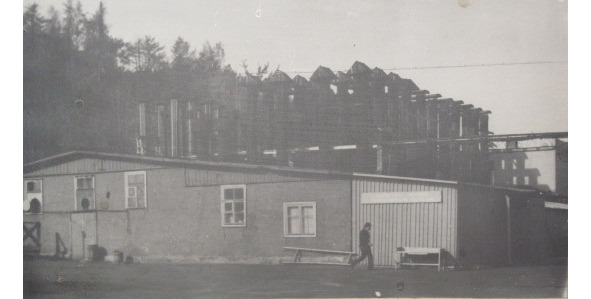
Smoking shop of fish built in 1948.
There were already 46 vessels in the UTF. The newspaper Kaliningrad Pravda wrote in October 1948: “… a large socialist industry is being created in the place of small artisanal fisheries.” It’s all true. But in fairness it is necessary to say about those difficult living conditions and work of fishermen in those hungry post-war years in the village of Pioneersk.
In 1947, Belov Ivan Antonovich was the secretary of the party bureau of the party organization. He was born in 1903, a secondary education, a member of the Communist Party since August 1937. He was later awarded the Medal for Valiant Work. And in the spring of 1949, having been approved by the 8th session of the Pioneersk Village Council of Workers, Chairman of the Council of Belov Ivan Antonovich assume a documents from the former Chairman of the Executive Committee of the Pioneersk Village Council of Labour Deputies since 1947 Alexandre Filimonikhina.
In their acceptance and surrender act of March 31, 1949, in the section “Housing and Utilities” read: “On the balance of housing and utilities of the Village Council there are 75 houses with a residential area of 8000 square meters. and a useful area of 750 square meters. employed for warehouses and retail outlets (shops, diners, teahouses). The state of the housing stock 80% requires an average repair and 20% requires an overhaul.…
The Pioneersk village has a 15-bed hospital with a maternity ward that is closed due to lack of food. Incomplete secondary school, which does not meet sanitary standards and is under-provided with equipment and inventory. Library in the number of books 1790 copies. The room requires repairs and crafts racks to accommodate books. Accepted tables of different 5, chairs hard – 2, reed chairs – 2, one stamp of the executive committee of the Pioneersk Village Council of Workers’ Deputies.
As of March 31, 1949, the village is not landscaped, the village does not have a public bath, there is a bath of fish factory, which is not equipped and does not meet sanitary requirements, the streets of the village are dirty and not illuminated, in the yards a lot of garbage, sewage, There are no public latrines and garbage bins, sewerage in the majority does not work, requires major repairs. The village in which most houses have no electricity, wiring in the houses is to be replaced and equipped. According to technical rules.
Chairman Pos. Council gave out / Philimonikhin /
Accepted by Chairman Pos. Council / Belov/
Spelling of the original preserved.”
Communist Belov, taking from Filimonikhin village in such a state understood how difficult it is for him to work. After all, there is not a penny in the budget of the village. What could have helped the management of the trawling fleet. But it was just beginning to get back on its feet and strengthen its economic position. It will then become a city-forming enterprise and will provide significant economic assistance not to the village, but to the city of Pioneersk. And despite all the difficulties, pioneersk fishermen continued to go out to sea. And even for a long time at that time (15 days) worked in the Baltic. Soon they were went on a herring expedition to Iceland together with the swimming base Tungus.
And the wives of fishermen gave birth to beautiful children in the maternity hospital in the city Cranz (German). There was no such opportunity in Pioneersk then. My mother-in-law lived in Georgienswald and gave birth in Cranz (German). And to see the light for my wife helped a midwife – a German. For that I am very grateful to her. It was at the end of June 1947.
On one of the hottest days of June 1947, the village of Neukuhren hosted another large family of migrants from the city of Krasnodar, Khoroshavina Nikolai Andreevich. As all this happened, I kindly reminded his daughter – Tamara Nikolaevna. This is a photo, that my camera left behind on March 12, 2019.
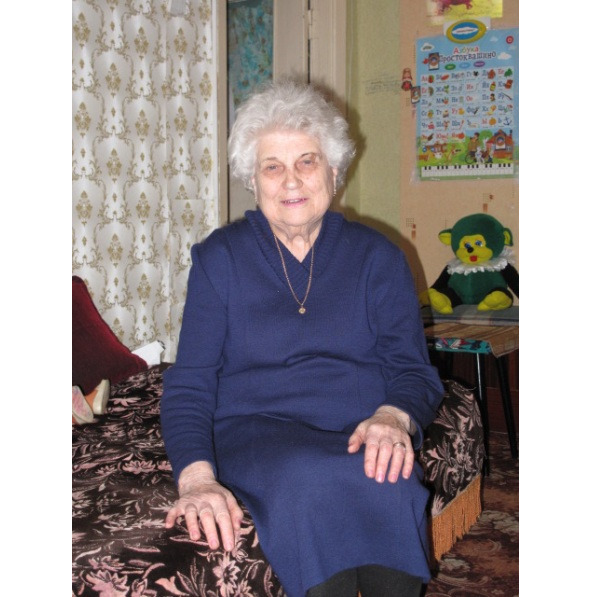
Tamara Nikolaevna.
Tamara has a good memory in her years. At home, she unmistakably calls for me the many names of captains and senior mechanics of the Pioneer Base of the Ocean Fishing Fleet. And this is not surprising. After all, she is the daughter of a famous captain. And this obliges to a lot. On four sheets of clean handwriting, she prepared for me the story of a beautiful family of a migrant – Khoroshavin Nikolai Andreevich. And I, without correcting almost anything, pass this story on to you, dear reader.
Nikolai Khoroshavin was born on November 29, 1913, in the village of Tara in the Omsk region. In 1939, Yakutia was called immediately to the front, when there was a war with the Finns. He was awarded the Order of the Red Star for his courage and bravery. In 1941 he left Krasnodar for the front of the Great Patriotic War. Defended the North Caucasus. He was also awarded medals. After the war, he returned to Krasnodar.
Soon Khoroshavin decided to enlist in the post-war Koenigsberg – the city of Kaliningrad. In the summer of 1947, he, his mother – Anna Vasilyevna, his wife – Evdokiy Pavlovna, and their three children arrived in the former Neukuhren – the village of Pioneers. Anna Vasilyevna began to work as a watchman of the smoking shop of the UTF fish factory. Evdokiy Pavlovna with her three children was a housewife. Their eldest daughter Tamara was born on May 11, 1936, the older brother Boris was born on September 18, 1938, the younger brother Nicholas was born on June 11, 1940.
On arrival in Kaliningrad, we were placed in the basement of a large red house on the square. There were a lot of migrants. The next day, Dad brought the whole family to Pioneers, to the UTF office. Captain Medvedev took us to his home in Lapineno, where we spent the night. The other night we spent on Komsomolskaya Street, where the house of the mode of life is now located. The next night we spent the night on the Railroad street 22, where Dad was given two rooms. There was no floor in one room and the window was not glazed. Dad laid this window with bricks. Grandmother Anna Vasilyevna began to work as a watchman of the smoke shop, which was located at the railway station of the village of Pioneers. She worked until 1949. Dad went to work at the port.
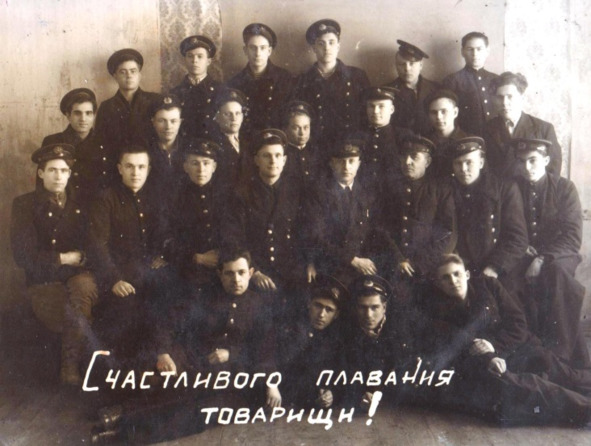
The students of the Mamonov “academy”. 1949.
He began to walk in the sea on KFC – 16 sailors. Then they went to the sea for three days. I used to meet my dad from the sea. In winter, the ship was often covered with ice. There was an open-air fish factory in the port. I remember, as my dad brought me on a boat, gave me paper and a pencil to draw. He put me in a navigator’s cabin so I wouldn’t go anywhere. And he went downstairs to unload the fish from the hold. Then I heard his voice. He was shouting at someone.

Khoroshavin Nikolai Andreevich and his wife.
I’ve always heard, “Faith, faith.” When I got home, I told my mother how my father shouted, “Faith, faith.” My mother asked my dad what Faith he was calling all the time. Dad laughed and said that “faith” is not a girl Vera, but a “vira” that means up. This word is used by all sailors.
Soon my father was sent to study at Mamonov “academy” as it was called at that time. In 1949, navigators for the fishing fleet were produced. And Dad started walking as an assistant captain. In this photo, my father and mother when Dad became the captain’s assistant. At one time he was an assistant captain at Chechetkin Arkady Vasilyevich. They had Markov Ilya as a mechanic. The Markovs lived above our apartment at 22 Railroad Street. I knew his wife, Douro, and his daughter Galya. Captain Dad began to work on MRT-256. They had a mechanic for Chehotkin Yuri. They then fought for the Passing Red Banner.
Once it was raining heavily, and I saw a picture of Dad on the board of honor. It was attached by buttons. I took it off and brought it home. My mom told me I shouldn’t have taken my dad’s picture. After all, he took the first place and the Passing Red Banner. But I didn’t want my dad’s picture to get wet in the rain. In our house lived the head of personnel Panfilov Vasily Mihailovich. He would often come to us for boiling water at lunch. Mom showed him a wet photo of Dad. The situation was corrected and soon the photo of my Dad was already on the board of honor under the glass.
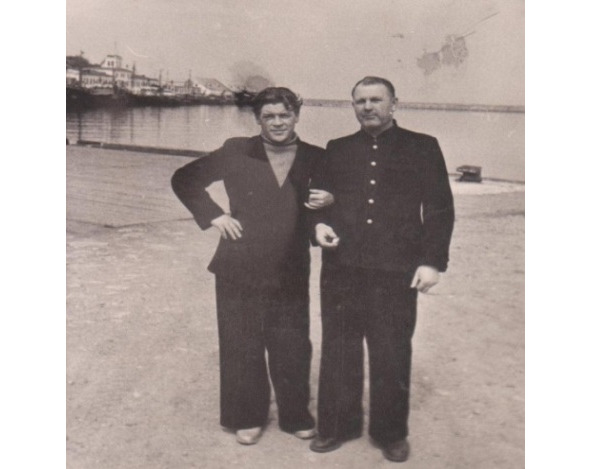
The captains Ermolaev and Khoroshavin.
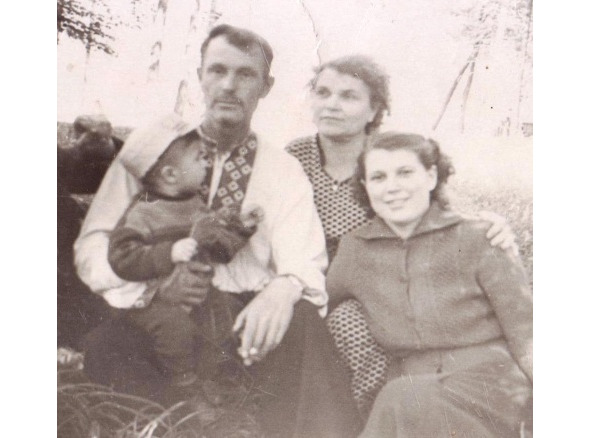
Family Khoroshavins.
Then the Panfilov family went to Tyumen. I also remember dad getting money for the team. I took them to the newspaper and in the net through the ravine, and my mother gave money to the wives of fishermen. I was 11 years old.
The captains of my childhood are Azarenko, Gorbachev Nikolai Petrovich, Dubrovin Titus, Medvedev, Chechetkin Arkady Vasilyevich, Firsov Alexander, Zimovin, Novostavsky, Ivanov, Yermolayev, Burdygo, Lysenko Ivan. Ivan Lysenko was a Hero of the Soviet Union. With his wife Anna and son, they lived in our house. I remember that his the Party sent somewhere to the East. And they left as a family. In the previous photo in the port are captains Yermolayev and Khoroshavin. I remember the mechanics – Markov Ilya, Baltukhov Vasily, Tilman Ludwig, Tabakov Nikolai, Balagurchik Victor. My brother Khoroshavin Nikolai was also a motorist and mechanic. The heads of the UTF were Ermoshkin, Sobolev, Kashirin. In this photo, which was taken in July 1957, Misha’s grandson was one year old.

Nikolai Andreevich and Galya.
Nikolai Andreevich has another granddaughter Galya. Pictured below in 1971, she shows her grandfather how to dance at a kindergarten party. Two great-grandchildren. Nikolai Nikolaevich walks in the sea from Kaliningrad on ships under someone else’s flag. There are two other
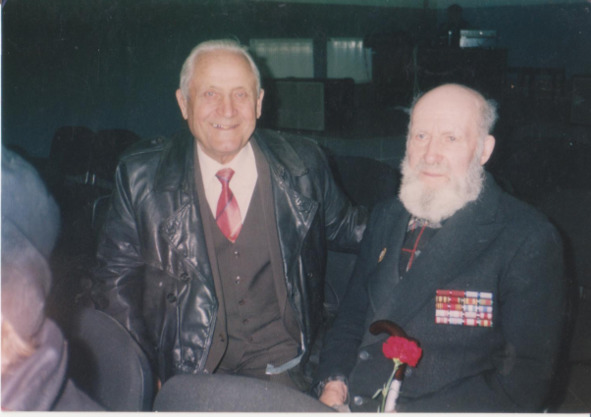
Captains Butov and Gorbachev N.P.
great-great-grandchildren – Alexander Nikolaevich is studying at the school for mechanics and Dmitry Mikhailovich is studying to be a navigator. Soon too will go to sea.
I would like to remind you about Captain Gorbachev Nikolai Petrovich. He’s a member of Great Patriotic War. He has the Order of the Red Star. During a storm in the Baltic in 1949—50, they in a trawl brought on board a bomb with iprit. The captain did not allow the team to her, and he suffered for it. He went to the hospital, four fingers were removed on one hand. Eyes began to see badly. Uncle Kolya had to go ashore. He started working in the control room.
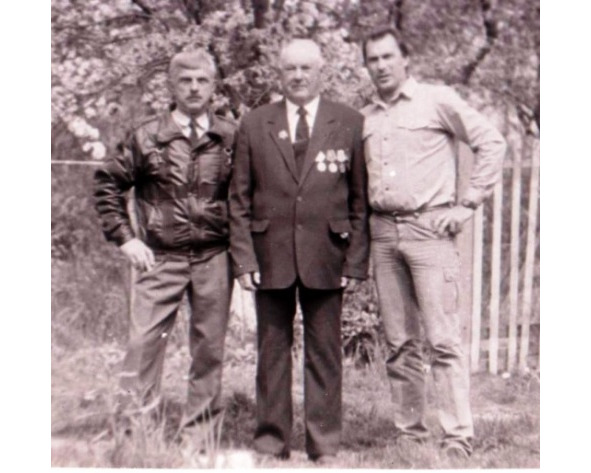
In this photo to the left of the pope – son Nicholas, on the right – grandson Michael.
Mikhail’s grandson Mikhail Kolyakov worked for a long time as a cargo assistant to the captain of the “Ural Mountains” from Reftransflot. The newspaper “Mayak” No. 6 (3895) of February 11, 1992 placed a photo of Mikhail Vasilyevich, when he was in charge of the work on the delivery of fish products in the port of Kaliningrad. The author of the note describes Michael as a neat and thorough person.

“Ural Mountains” in the port of Kaliningrad.
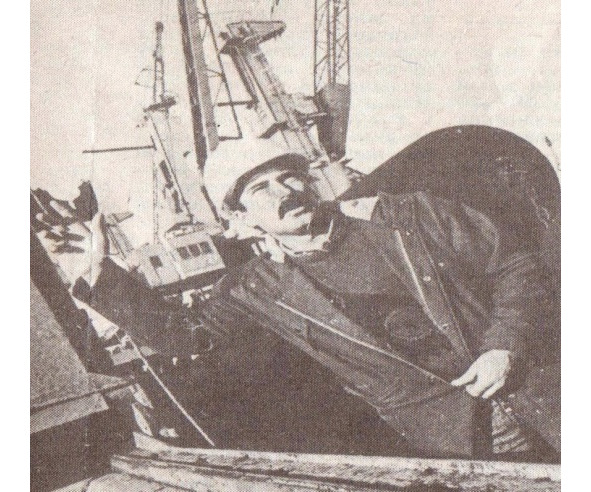
Mikhail Vasilyevich.
Tamara Nikolaevna looks very good in her years. She keeps as a memory everything connected with the family Khoroshavins. She is sure that the second edition of the book about the Pioneers base of the ocean fishing fleet will see the light of day and find its sponsor, which will allow presenting the book to still living veterans of the base. It just so happened that Tamara Nikolaevna was left alone. Her second husband, Nikolai Petrovich (pictured below), also died. He worked as the captain’s first assistant at Reftransflot. And his father, Khoroshavin Nikolai Andreevich, died on May 9, 1994. Beautiful children, grandchildren, and great-grandchildren help to live on.

